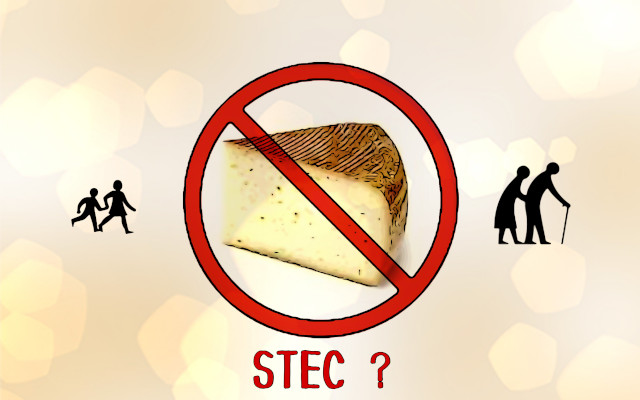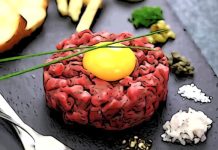‘Alpine’ and other fresh or semi-fresh raw-milk cheeses expose the most vulnerable consumers to the serious risk of contracting toxins with severe complications, due to contamination with theShiga toxin-producing Escherichia coli (STEC) pathogen.
1) Fresh raw milk cheeses, the STEC danger.
The Italian news these days reports the case of a two-year-old girl, hospitalized since July 2023 at the Hospital of Padua due to a hemolytic-uremic syndrome caused by the consumption of an ‘alpine’ cheese made from raw cow’s milk. (1)
The incriminated cheese was produced in an area of Trentino where a similar incident had already occurred in 2017, endangering the life of a four-year-old boy, who also suffered from hemolytic uremic syndrome that led him into a vegetative state. (2)
2) STEC, hemolytic uremic syndrome and other complications.
STEC(Shiga toxin-producing Escherichia coli) is the acronym used to describe very virulent strains of Escherichia coli that synthesize the dangerous Shiga toxins (3,4).
The pathogenic action of STEC, like that of other E. coli strains, first affects the intestine and is manifested by symptoms of diarrhea within a few days after exposure to the microorganism. Complications-as in most pathogens, bacterial (e.g., Listeria monocytogenes) and viral (e.g., Norovirus. See notes 5,6)-are then related to individual vulnerability. Thus:
– in several patients, the symptoms of STEC infection are limited to the gut and do not differ from other similar foodborne toxins,
– in more fragile individuals, such as preschool children and the elderly, however, Shiga toxins can cause vascular injury in various organs such as intestine, kidney, and brain tissue. Thus causing hemorrhagic colitis, renal failure, and neurological lesions typical of hemolytic-uremic syndrome, depending on the case.
Hemolytic uremic syndrome is a very serious condition involving kidney dysfunction that tends to become chronic with possible, incurable neurological complications.
3) Dairy foods at risk.
Ruminants-cattle, sheep, and goats-can harbor STEC bacteria in their intestines without therefore being subjected to their pathogenic action, and eliminate them with their droppings. Adult ruminants can therefore act as reservoirs of STECs, in the absence of gastrointestinal symptoms, and be milked regularly or sent for slaughter without the need for further investigation of their health condition.
Raw milk can become contaminated during milking–by contact with the animal’s feces, often present on the udder skin–or otherwise in the barn, through the use of unsanitized equipment or containers. However, STECs can be inactivated by appropriate heat treatment, pasteurization at +72°C for at least 15 seconds or at +63°C for at least 30 minutes. Accordingly:
– raw milk, fresh and semi-cured raw milk cheeses are at risk of STEC contamination. (7)
As for cheeses, an adequate aging process (not less than 60 days) creates an unfavorable environment for bacterial survival, including STEC, due to lactic acid bacteria fermentations that increase the acidity of the paste and salting that reduces the water content available to microorganisms.
4) STEC-free foods.
The ‘STEC danger’ does not exist for:
- raw milk that is boiled before consumption, as prescribed by OM 10.12.2008,
- Pasteurized or sterilized milk (where the temperature reaches +135°C),
- Cheeses made from pasteurized milk,
- Aged hard cheeses, if also from raw milk. Long curing, often exceeding 12 months, combined with salting hinders bacterial survival.
5) Recommendations to consumers
It is not recommended that unpasteurized or boiled raw milk, fresh and semi-fresh raw milk cheeses be given to preschool children, the elderly, and the immunocompromised.
6) Useful prohibitions
Food business operators have a duty to prevent control and mitigate all possible food safety risks. Self-control-which integrates GHPs(Good Hygienic Practices) with theHazard Analysis on Critical Control Points (HACCP) system-must first consider the most serious hazards, such as precisely STEC and Listeria pathogens in animal productions.
The Ministry of Health moreover – given the non-negligible recurrence, in Italy as well as at the EU level, of toxins and recalls of STEC-contaminated products (8) – could consider the introduction of emergency measures such as banning the feeding of raw milk cheeses to pre-school children (6 years old), the elderly and other residents of assisted living facilities.
Silvia Bonardi and Dario Dongo
Notes
(1) Daphne Roat. 2-year-old girl in hospital since July blamed on alpine cheese: confirmation in tests. The little girl is serious. Corriere del Trentino (The Evening Courier). 2.9.23
(2) Matteo Lunelli. 4-year-old girl in intensive care in Padua. Escherichia coli bacteria in contaminated cheese. The precedent: six years ago a child in a coma. The Adige. 21.9.23
(3) Bonardi Silvia. “Pathogenic Escherichia coli. In: Food hygiene and technology. Ed. G. Colavita. Point Vétérinaire Italie editore, Milan, 2023; pp. 121-126
(4) Silvia Bonardi, Dario Dongo. STEC in cheeses, in-depth study. GIFT(Great Italian Food Trade). 30.10.18
(5) Dario Dongo. Listeria, a dangerous pathogen out of control. GIFT(Great Italian Food Trade). 19.8.23
(6) Silvia Bonardi. Norovirus in seafood, how to protect yourself. GIFT(Great Italian Food Trade). 10.7.23
(7) Dos Santos Rosario AIL, da Silva Mutz Y, Castro VS, da Silva MCA, Conte-Junior CA, da Costa MP. Everybody loves cheese: crosslink between persistence and virulence of Shiga-toxin Escherichia coli. Critical Reviews in Food Science and Nutricion 2021;61(11):1877-1899. doi: 10.1080/10408398.2020.1767033.
(8) RASFF Report 2022 reports 26 STEC alerts out of 199 alerts related to microbiological hazards on meats other than poultry, as well as the third highest STEC (after salmonella and listeria) on milk and dairy products. See sections 5.3, 5.4 in the previous article Dario Dongo, Marta Strinati. RASFF 2022, EU food security report. GIFT(Great Italian Food Trade). 1.8.23









